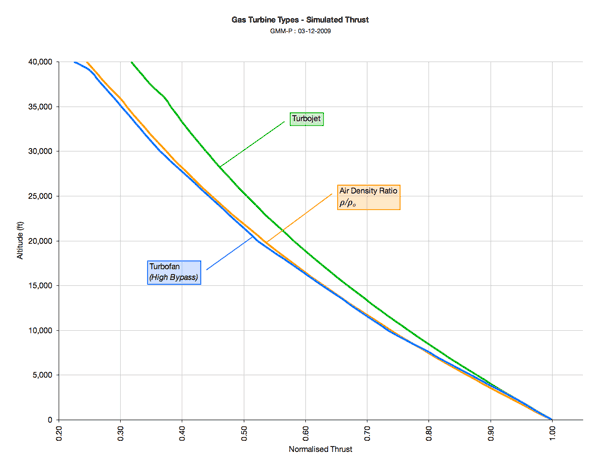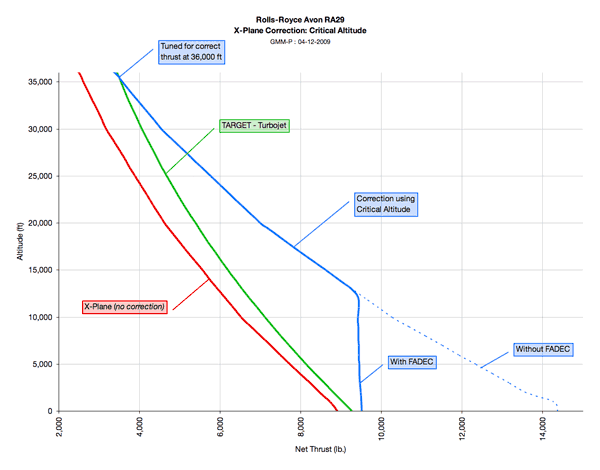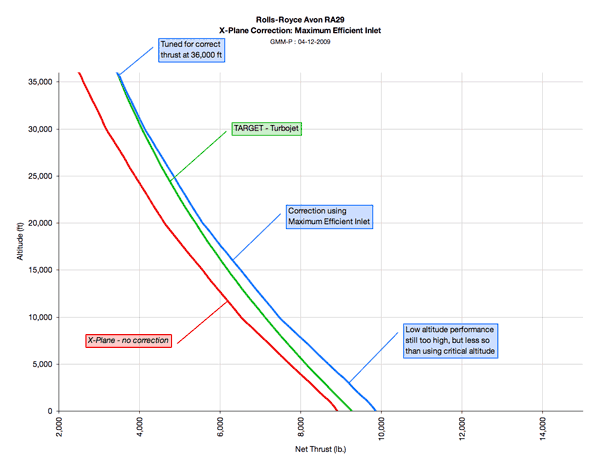Comet 4c - Engine Performance
04/01/10 09:00
Before Christmas, I spent a lot of time investigating the cause of inadequate thrust at high altitude. The Comet would not reach its ceiling, and required full throttle to cruise at 30,000 feet.
X-Plane simulates two kinds of jet engine: low-bypass and high-bypass turbofans. It does not simulate pure turbojets. Turbojets are the simplest kind of jet engine, expelling a fast, narrow stream of very hot gas that rips against the surrounding air, producing an awful lot of noise and wasted energy. Ideally, one wants exactly the opposite: a massive stream of air moving only slightly faster than the surrounding air.
Bypass engines have a central core which is still recognisable as a turbojet, with the addition of a large, cold-air fan on the front, driven by the turbine-shaft. In that respect, it’s not that different from a turbo-prop, but instead of driving a propellor, it’s driving a ducted fan. However, where a turboprop’s only function is to turn a shaft, a turbofan also uses the jet exhaust from the central “gas generator” to contribute to total thrust, blending it with the larger volume of cooler, slower air from the fan. High bypass engines have an enormous fan, with a broad stream of relatively cool, relatively slow air; they are a lot quieter than a turbojet, very much more efficient, and have a far greater potential for maximum thrust.
As speeds rise, the relative velocity of the jet efflux compared to the surrounding air is reduced, and the thrust of a jet engine tails off. At very high speeds (or very high altitude) the faster gas flow of a pure turbojet comes into its own. Low bypass turbofans seek the best of both worlds: they have a much smaller fan, so a greater proportion of their output is the fast, hot stream from the central gas generator. It’s easy to see how the bypass ratio plays a major part in the suitability of an engine for a particular aircraft.
In X-Plane, jet engine thrust is proportional to the ratio of the density of air at altitude over the density of air at sea level, which is approximately correct for a large bypass engine. A pure turbojet produces far less thrust overall; perhaps only a quarter of a modern bypass engine, but it retains a greater proportion of it’s maximum thrust at high altitude. The first graph shows normalised* thrust at constant I.A.S. (ie rising Mach number).

The gap in performance is considerable at 40,000 feet, with the X-Plane engines producing only half the thrust that the real Rolls-Royce Avon engines were capable of. Plane Maker offers three alternatives: to increase the maximum thrust at sea level, to raise the critical altitude at which maximum thrust is produced, to increase the maximum efficient inlet mach number, or a combination of all three. For me, the first option is not worth considering. The maximum thrust figure in the box should be the figure quoted by the original manufacturer.
Critical Altitude
For the test, I decided to adjust the critical altitude setting so that the correct thrust was achieved at 36,000 feet: an efficient cruising altitude for the Comet 4C (critical altitude = 17,000 ft). As you will see from the second graph, this has the effect that the gradient has changed in the wrong direction. There is more than 60% too much thrust at sea level. Using FADEC caps the thrust, but performance between 10,000 and 25,000 feet is so unrealistic, it would be as if the Comet had re-heat.

Maximum Efficient Inlet Mach
In a similar way, I adjusted the maximum efficient inlet mach so that the X-Plane model achieved the correct thrust at 36,000 ft (the figure in Plane Maker needed to be 2.00M, which is nonsense, but put that thought to one side for the moment). The result is not perfect: the gradient of the curve is still wrong: above 36,000 feet, the thrust still rolls off unrealistically, but it achieves a good overall balance for a range of normal operating altitudes, and the thrust boost at sea level is only 10%.

*Normalised thrust: ie, as a proportion of maximum thrust, where maximum thrust at sea-level = 1.
--
GMM-P (04/01/2010)
X-Plane simulates two kinds of jet engine: low-bypass and high-bypass turbofans. It does not simulate pure turbojets. Turbojets are the simplest kind of jet engine, expelling a fast, narrow stream of very hot gas that rips against the surrounding air, producing an awful lot of noise and wasted energy. Ideally, one wants exactly the opposite: a massive stream of air moving only slightly faster than the surrounding air.
Bypass engines have a central core which is still recognisable as a turbojet, with the addition of a large, cold-air fan on the front, driven by the turbine-shaft. In that respect, it’s not that different from a turbo-prop, but instead of driving a propellor, it’s driving a ducted fan. However, where a turboprop’s only function is to turn a shaft, a turbofan also uses the jet exhaust from the central “gas generator” to contribute to total thrust, blending it with the larger volume of cooler, slower air from the fan. High bypass engines have an enormous fan, with a broad stream of relatively cool, relatively slow air; they are a lot quieter than a turbojet, very much more efficient, and have a far greater potential for maximum thrust.
As speeds rise, the relative velocity of the jet efflux compared to the surrounding air is reduced, and the thrust of a jet engine tails off. At very high speeds (or very high altitude) the faster gas flow of a pure turbojet comes into its own. Low bypass turbofans seek the best of both worlds: they have a much smaller fan, so a greater proportion of their output is the fast, hot stream from the central gas generator. It’s easy to see how the bypass ratio plays a major part in the suitability of an engine for a particular aircraft.
In X-Plane, jet engine thrust is proportional to the ratio of the density of air at altitude over the density of air at sea level, which is approximately correct for a large bypass engine. A pure turbojet produces far less thrust overall; perhaps only a quarter of a modern bypass engine, but it retains a greater proportion of it’s maximum thrust at high altitude. The first graph shows normalised* thrust at constant I.A.S. (ie rising Mach number).

The gap in performance is considerable at 40,000 feet, with the X-Plane engines producing only half the thrust that the real Rolls-Royce Avon engines were capable of. Plane Maker offers three alternatives: to increase the maximum thrust at sea level, to raise the critical altitude at which maximum thrust is produced, to increase the maximum efficient inlet mach number, or a combination of all three. For me, the first option is not worth considering. The maximum thrust figure in the box should be the figure quoted by the original manufacturer.
Critical Altitude
For the test, I decided to adjust the critical altitude setting so that the correct thrust was achieved at 36,000 feet: an efficient cruising altitude for the Comet 4C (critical altitude = 17,000 ft). As you will see from the second graph, this has the effect that the gradient has changed in the wrong direction. There is more than 60% too much thrust at sea level. Using FADEC caps the thrust, but performance between 10,000 and 25,000 feet is so unrealistic, it would be as if the Comet had re-heat.

Maximum Efficient Inlet Mach
In a similar way, I adjusted the maximum efficient inlet mach so that the X-Plane model achieved the correct thrust at 36,000 ft (the figure in Plane Maker needed to be 2.00M, which is nonsense, but put that thought to one side for the moment). The result is not perfect: the gradient of the curve is still wrong: above 36,000 feet, the thrust still rolls off unrealistically, but it achieves a good overall balance for a range of normal operating altitudes, and the thrust boost at sea level is only 10%.

*Normalised thrust: ie, as a proportion of maximum thrust, where maximum thrust at sea-level = 1.
--
GMM-P (04/01/2010)
blog comments powered by Disqus
